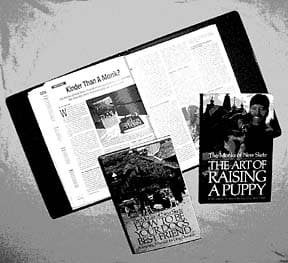Dear readers,
In the November 1999 issue of WDJ, we published an article by Pat Miller, our lead writer on training issues, that discussed the books published by and about the Monks of New Skete. To briefly recap the article, Miller complimented the Monks for being among the first trainers to promote – with the publication of their 1978 book How To Be Your Dog’s Best Friend – the concept of building a positive relationship with your dog while training it to be a pleasurable companion, as opposed to an old-fashioned, obedience-at-any-cost style of training that had been prominent in the 1950s and 1960s. However, Miller also noted that while the Monks’ successful books very much helped popularize a more positive style of training, there are still a number of aspects of the Monks’ program that are somewhat outdated from the perspective of trainers who advocate positive training.

We don’t generally “name names” when criticizing training techniques we don’t approve of; after all, it’s the methods, not the trainers who use them, that we want people to consider. But in this case, who the people are is important to the story. Many, many people are under the impression that there can’t possibly be a more peaceable trainer than a monk. And if monks wrote a book about dog training, wouldn’t you imagine it would advocate only nonviolent training techniques? But the Monks of New Skete do advocate the use of some physically forceful training methods, anathema to WDJ’s philosophies on training.
Following publication of the November article, we received a letter from Brother Christopher, a member of the Monks of New Skete. Brother Christopher thought Miller’s article was largely inaccurate, and wanted to defend the Monk’s methods.
I was struck by two things upon reading the letter. First, I think it’s likely that, prior to seeing the November 1999 issue, Brother Christopher was unfamiliar with WDJ. He speaks of Miller’s (and, by extension, WDJ’s) “unspoken agenda,” without realizing, perhaps, that we very much have a stated agenda. Much of his letter articulates the view of many trainers who use verbal and physical punishment in their training program and who not only see nothing wrong with it, but also see it as an important and useful part of training.
Second, I think Brother Christopher is also unaware of our bias against breeders whose sole interest in producing puppies is financial. We are not opposed to the concept of breeding altogether, though, at present there certainly are too many dogs in the world, as evidenced by the outrageous numbers of dogs put to death in shelters each year. We have seen (and written about) breeders, who, through limited breeding, limited registration, and puppy contracts, are attempting to add to the dog population in a limited and responsible way. These people will admit to using the sale of puppies to recoup some losses incurred through keeping their dogs, but can readily explain how, unless one is breeding “too many” dogs, you can’t make a profit at it. In our opinion, if economics precludes breeding stock from being kept in the family past their “useful” age, then breeding should stop. We respect the fact that other people have other views, and we think that professional, respectful dialogue with them can help readers make up their own minds.
Taking a stand
But readers should be aware of the difference between WDJ and other dog publications: We do have an editorial position. We don’t sit on the fence, presenting articles about nonviolent training and force-based training in equally flattering light, pretending we don’t regard one as “better” or that we don’t care which one people use! We don’t present all products as being equally effective and useful as a hedge against losing advertising income. (We don’t take advertising, so that we have nothing to lose by saying some products are without merit.)
We know “our” way is not the only way; we are aware that verbal and physical punishment can be effective in changing a dog’s behavior. But we have consistently held the position that there are equally (if not more) effective, nonviolent ways to change a dog’s behavior. We also believe that these positive methods are more enjoyable for the dog and the trainer. Brother Christopher’s letter to WDJ is an articulate expression of certain views that are contrary to ours. In this issue, you’ll find the entire letter, as well as Pat Miller’s response to it. We’re not printing the discussion in order to correct either Miller or Brother Christopher, but because we think that both authors represent their respective opinions well, and we want you to make up your own minds.
As you live and work with your dog day-to-day, pay attention to how you treat him, how he responds, and how the relationship feels. And then choose the methods that are most likely to improve all those things. Most likely, they’ll be positive!
– Nancy Kerns, Editor






